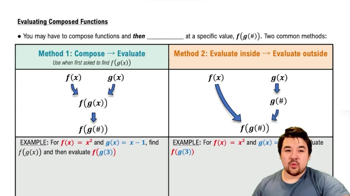Table of contents
- 0. Functions7h 52m
- Introduction to Functions16m
- Piecewise Functions10m
- Properties of Functions9m
- Common Functions1h 8m
- Transformations5m
- Combining Functions27m
- Exponent rules32m
- Exponential Functions28m
- Logarithmic Functions24m
- Properties of Logarithms34m
- Exponential & Logarithmic Equations35m
- Introduction to Trigonometric Functions38m
- Graphs of Trigonometric Functions44m
- Trigonometric Identities47m
- Inverse Trigonometric Functions48m
- 1. Limits and Continuity2h 2m
- 2. Intro to Derivatives1h 33m
- 3. Techniques of Differentiation3h 18m
- 4. Applications of Derivatives2h 38m
- 5. Graphical Applications of Derivatives6h 2m
- 6. Derivatives of Inverse, Exponential, & Logarithmic Functions2h 37m
- 7. Antiderivatives & Indefinite Integrals1h 26m
- 8. Definite Integrals4h 44m
- 9. Graphical Applications of Integrals2h 27m
- 10. Physics Applications of Integrals 2h 22m
2. Intro to Derivatives
Derivatives as Functions
Problem 3.2.23a
Textbook Question
21–30. Derivatives
a. Use limits to find the derivative function f' for the following functions f.
f(x) = 4x²+1; a= 2,4
 Verified step by step guidance
Verified step by step guidance1
Start by recalling the definition of the derivative using limits: f'(x) = lim(h→0) [(f(x+h) - f(x))/h].
Substitute the given function f(x) = 4x² + 1 into the derivative definition: f'(x) = lim(h→0) [(4(x+h)² + 1 - (4x² + 1))/h].
Expand the expression (x+h)² to get x² + 2xh + h², and substitute it back into the limit: f'(x) = lim(h→0) [(4(x² + 2xh + h²) + 1 - 4x² - 1)/h].
Simplify the expression inside the limit: f'(x) = lim(h→0) [(4x² + 8xh + 4h² + 1 - 4x² - 1)/h] = lim(h→0) [(8xh + 4h²)/h].
Factor out h from the numerator and cancel it with the denominator: f'(x) = lim(h→0) [8x + 4h]. As h approaches 0, the term 4h vanishes, leaving f'(x) = 8x.
 Verified video answer for a similar problem:
Verified video answer for a similar problem:This video solution was recommended by our tutors as helpful for the problem above
Video duration:
4mPlay a video:
Was this helpful?
Key Concepts
Here are the essential concepts you must grasp in order to answer the question correctly.
Derivative
The derivative of a function measures how the function's output value changes as its input value changes. It is defined as the limit of the average rate of change of the function over an interval as the interval approaches zero. In mathematical terms, the derivative f'(x) is given by the limit: f'(x) = lim(h→0) [f(x+h) - f(x)] / h.
Recommended video:

Derivatives
Limit
A limit is a fundamental concept in calculus that describes the behavior of a function as its input approaches a certain value. It is essential for defining derivatives and integrals. The limit allows us to analyze the function's behavior at points where it may not be explicitly defined, such as at points of discontinuity or at infinity.
Recommended video:

One-Sided Limits
Function Evaluation
Function evaluation involves substituting a specific value into a function to determine its output. In the context of finding derivatives, evaluating the function at points a=2 and a=4 is necessary to compute the derivative using the limit definition. This process helps in understanding how the function behaves at those specific points.
Recommended video:

Evaluating Composed Functions
Related Videos
Related Practice



